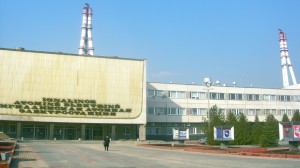
The Ignalina Nuclear Power Plant's design was too similar to Chernobyl for the European Union to stomach, so it's closure was one of the conditions of Lithuania's EU accession in 2004. Photo by Marius Davainis.
VILNIUS — The Lithuanian government announced Monday that it will issue a tender by the end of this year for a majority stakeholder in the next proposed nuclear power plant.
The forthcoming power plant, which is projected to be completed by 2020, is intended to replace the Ignalina Nuclear Power Plant, which produced 80 percent of the country’s energy. Ignalina, which has plans similar to the Chernobyl plant, will be dismantled at the end of this year as a precondition for joining the European Union.
The government hopes to sign the deal by the second half of 2010. According to the Ministry of Energy, it is expected to cost between €3-5 billion.
According to a monitoring report released by the Ministry of Energy this year, Ignalina exported energy to Latvia, Estonia, Belarus, Finland, and Russia in 2008. Of those countries, 45 percent of the power exports went to Estonia, and 23 percent went to Latvia.
Since Lithuania’s accession into the EU, the government has approached other countries, namely Poland and Sweden, for energy partnerships. According to the 2009 monitoring report, it is in order to “help reduce dependency on Russia after the closure of Ignalina.”
“Lithuania will not be dependent on the Russian import of electricity,” Kęstutis Jauniškis, adviser to the energy minister told Baltic Reports. “Next year, Lithuania is planning to purchase approximately 35 percent of necessary electric power in the market. The volumes shall annually increase in 10 percent and up to the year 2015 we expect to implement the market model in 100 percent.”
Lithuania plans to buy from Estonia, the Scandinavian nations, Ukraine and Russia.
On Monday, energy minister Arvydas Sekmokas told Reuters that energy companies like Germany’s E.ON and RWE, France’s EDF, Spain’s Iberdrola, Finland’s Fortum, and Sweden’s Vattenfall were expected to take part in the tender. Although he declined to name any companies participating in the tender, he said that the competition for selecting a strategic investor will be announced in December. The Latvian and Estonian governments are also committed to helping finance the new plant.
Jauniškis said that the ministry expects energy prices to rise ten cents per kilowatt hour as a result of the competitive open market. He called Ignalina a “monopoly,” echoing comments President Dalia Grybauskaitė made in August, and said that “other producers of electric power have not been able to compete in the market effectively … the presence of the monopoly in the market did not provide many advantages in the economy.”
The privatization of the energy market has been a long-term goal of Lithuania’s ruling conservative coalition. In September, Lithuania dissolved LEO LT, government-NDX Energija joint venture tasked with building Ignalina’s replacement, after the company’s creation under the previous Social Democratic government was declared unconstitutional in March by the Constitutional Court. NDX Energija was given a final offer Wednesday of 680 million litai (€196 million) as return for their initial investment in LEO LT, the same amount the company paid for its improperly-handled privatization of the VST power grid in 2003.












